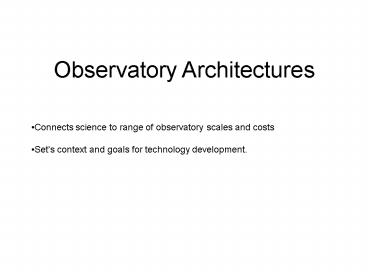Observatory Architectures - PowerPoint PPT Presentation
1 / 12
Title: Observatory Architectures
1
Observatory Architectures
Connects science to range of observatory scales
and costs Sets context and goals for
technology development.
2
Range of Mission Opportunities and Scales for
Planet Imaging
3
Two Basic Architecturesfor High-Contrast Imaging
Internal Coronagraphy
Control stellar halo via diffraction control or
interference inside telesocope.
Requires active wavefront sensing and control
Contrast and iwa scale with telescope diameter
Typically narrow band Operations limited by
exposure time and iwa
External Occultation
Remove starlight via an external starshade and
collect planet photons with conventional
telescope.
Eliminates need for WFSC Contrast and iwa
scale with occulter size and distance
Challenging engineering and control Operations
limited by slew time and revisits
4
Internal Coronagraph Scales
- Ground Telescopes with ExAO
- Young giants, debris disks, hot Jupiters
- Limited by atmosphere and speed of AO
- Suborbital Balloons and Sounding Rockets
- Bright Jovians, disks, technology development
- Limited by size and stability
- Small Missions (SMEX/MIDEX)
- Planet forming regions, debris disks, exozodi
- Limited by cost (low resolution, reduced contrast)
5
Internal Coronagraph Scales
- Probe Class (1 - 2 m)
- Jovian planets, Super-Earths, Exozodi
- Limited by iwa and integration time
- Flagship Class (4 - 8 m)
- Terrestrial planets
- Limited by cost and stability
6
(No Transcript)
7
External Occulters
All are flagship scale targeted at terrestrial
planets
- Single External Occulter
- Limited by size and distance of occulter
- Multiple Occulters
- Limited by cost and launch vehicles
- Hybrid Coronagraph/Occulter
- Limited by stability and iwa
8
(No Transcript)
9
Mission Completeness Studies
Need to continue refining analysis and create
program science estimates for different scales.
10
Completeness
Completeness is the number of planets observed
out of a distribution in all possible orbits in
the habitable zone of a given target
star. Optimized completeness finds the shortest
integration time that still discovers all
observable planets for a star of given
luminosity. Total optimized program completeness
simultaneously optimizes integration time (min
?mag of planet) and revisits over population of
stars to maximize number of planets discovered at
fixed probability of missed detection.
Observable Planets
11
Single/Multiple Visit Completeness
iwa 60 mas
iwa 57 mas
12
(No Transcript)































